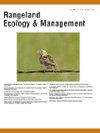Prioritizing Accuracy or Efficiency: Comparing General Allometric Models for Perennial Bunchgrass Species
IF 2.4
3区 环境科学与生态学
Q2 ECOLOGY
引用次数: 0
Abstract
Aboveground biomass is important, yet difficult to estimate in dryland ecosystems due to high spatial heterogeneity and the variability of graminoid growth form and density. Allometric relationships are one method of estimating above-ground biomass of forage resources. These models use growth characteristics such as height or diameter to predict biomass. While allometry in forest ecosystems is common, biomass estimation in grasslands and shrublands is primarily based on harvesting or percent cover. Cover estimates vary among researchers and require double sampling at each site to create a relationship between cover and biomass. Multispecies (general) allometric models for high value forage groups, like perennial bunchgrasses, could increase the efficiency of biomass estimation by eliminating the need for destructive sampling. While some general models exist, few studies focus on the application of these models to locations outside the training populations. We tested the applicability of a general bunchgrass model to locations not included in model training against general models developed using biomass samples from our focal sites. We found that our general bunchgrass model trained on data we collected in 2019 made accurate predictions at 76% of sites and that this model outperformed a general bunchgrass model trained on data collected at different sites and by a different research group, which made accurate predictions at 64% of our sites. Despite the loss in accuracy, our study highlights the potential value in further developing general allometric equations for perennial grasses through the development of a grass database. This database may lead to the development of general models with higher confidence in extrapolation beyond the training populations increasing both efficiency and accuracy for land managers.
准确性与效率孰优孰劣:多年生禾本科植物异速生长模型的比较
在旱地生态系统中,地上生物量很重要,但由于禾本科生长形式和密度的高空间异质性和变异性,地面生物量难以估计。异速生长关系是估算牧草地上生物量的一种方法。这些模型利用生长特征,如高度或直径来预测生物量。虽然森林生态系统中的异速生长很常见,但草地和灌丛的生物量估算主要基于采伐或覆盖率。研究人员对覆盖范围的估计各不相同,并且需要在每个地点进行两次采样,以建立覆盖范围和生物量之间的关系。多年生禾本科牧草等高价值牧草群的多种(一般)异速生长模型可以通过消除破坏性采样的需要来提高生物量估算的效率。虽然存在一些一般模型,但很少有研究关注这些模型在培训人群以外的地点的应用。我们测试了一般束草模型对未包括在模型训练中的位置的适用性,而不是使用我们的焦点站点的生物量样本开发的一般模型。我们发现,根据2019年收集的数据训练的一般束草模型在76%的网站上进行了准确的预测,并且该模型优于根据不同网站和不同研究小组收集的数据训练的一般束草模型,后者在64%的网站上进行了准确的预测。尽管准确性有所下降,但我们的研究强调了通过开发牧草数据库进一步开发多年生牧草的一般异速生长方程的潜在价值。这个数据库可能导致开发出一般模式,在训练人口之外的外推方面具有更高的可信度,从而提高土地管理人员的效率和准确性。
本文章由计算机程序翻译,如有差异,请以英文原文为准。
求助全文
约1分钟内获得全文
求助全文
来源期刊

Rangeland Ecology & Management
农林科学-环境科学
CiteScore
4.60
自引率
13.00%
发文量
87
审稿时长
12-24 weeks
期刊介绍:
Rangeland Ecology & Management publishes all topics-including ecology, management, socioeconomic and policy-pertaining to global rangelands. The journal''s mission is to inform academics, ecosystem managers and policy makers of science-based information to promote sound rangeland stewardship. Author submissions are published in five manuscript categories: original research papers, high-profile forum topics, concept syntheses, as well as research and technical notes.
Rangelands represent approximately 50% of the Earth''s land area and provision multiple ecosystem services for large human populations. This expansive and diverse land area functions as coupled human-ecological systems. Knowledge of both social and biophysical system components and their interactions represent the foundation for informed rangeland stewardship. Rangeland Ecology & Management uniquely integrates information from multiple system components to address current and pending challenges confronting global rangelands.
 求助内容:
求助内容: 应助结果提醒方式:
应助结果提醒方式:


